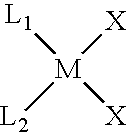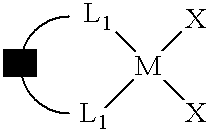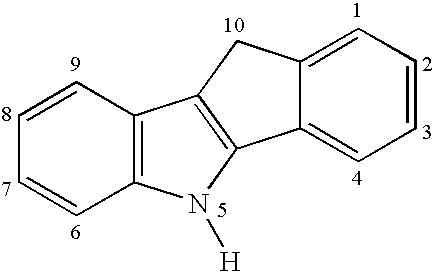Process for the preparation of multimodal polyethylene resins
a polyethylene resin and multi-modal technology, applied in the direction of bulk chemical production, etc., can solve the problems of high cost, high cost, and high cost and achieve the effect of improving the efficiency of catalysts and/or different activators
- Summary
- Abstract
- Description
- Claims
- Application Information
AI Technical Summary
Benefits of technology
Problems solved by technology
Method used
Image
Examples
example 1
Preparation of Supported Mixed Indenoindolyl Catalyst
[0043]A non-bridged indenoindolyl catalyst component, (5,10-hydro-5,8-dimethylindeno[1,2-b]indole-10-yl)(cyclopentadienyl)zirconium dichloride, was prepared in accordance with the procedure of Example 2 of published U.S. patent application 2007 / 0055021A. The non-bridged indenoindolyl catalyst is abbreviated “NBC” in the examples and tables which follow.
[0044]A bridged indenoindolyl catalyst component, rac-ansa(methylene)bis(2,5-dimethyl-indeno[2,1-b]indolyl)zirconium dichloride, was prepared in accordance with the procedure described in Example 1 of published U.S. patent application 2007 / 0293639A. The bridged indenoindolyl catalyst component is abbreviated “BC” in the examples and tables which follow.
[0045]Silica (Fuji G-3) was calcined under flowing nitrogen for 16 h at 200° C. Methylalumoxane (1.9 mL of a 30 wt % solution in toluene, a product of Albemarle) was dissolved in 30 mL of toluene. This toluene solution was then added ...
example 2
Polymerization of Polyethylene Resin
[0047]Ethylene, butene-1, hexane, the supported mixed catalyst from Example 1, TIBAL cocatalyst and hydrogen were continuously fed into a first 100 gallon stirred tank reactor to make a LMW HDPE resin. The reactor contained 80 gallons of reaction mixture. A small amount of anti-static agent (Armostat™ 710) was also added. Feed rates and polymerization conditions in the first reactor were as follows:
Temperature160°F.Pressure79psigEthylene30lb / hrButene-10.19lb / hrHexane193lb / hrCatalyst2.57g / hrCocatalyst0.47g / hrAnti-stat3.41g / hrH2 / Ethylene mole ratio0.0012
[0048]Polymerizate, i.e., reaction mixture, from the first reactor was continuously removed and transferred to a flash drum where hydrogen and ethylene were removed. The slurry recovered from the flash drum was transferred to a second 100 gallon stirred tank reactor where a higher MW lower density PE resin (HMW PE) was produced in the presence of the LMW HDPE polymer particles. The second reactor con...
example 3
[0057]To demonstrate the versatility of the process, Example 2 was repeated except that the conditions were selected to target formation of resin having a narrower molecular weight distribution and higher density. Feed rates and reactor conditions used were as follows:
First ReactorSecond ReactorTemperature (° F.)160170Pressure (psig)56121Ethylene (lb / hr)2035Butene-1 (lb / hr)—0.75Hexane (lb / hr)193100Catalyst (g / hr)3.07—Cocatalyst (g / hr)0.930.93Anti-Stat (g / hr)4.102.04H2 / Ethylene mole ratio0.00130.00014
The resulting multimodal resin blend was comprised of 36 wt. % LMW HDPE produced in the first reactor and 64 wt. % HMW PE produced in the second reactor. Properties of the finished polymer pellets and bubble stability rating were as follows:
MI2 (g / 10 min)0.108HLMI (g / 10 min)9.3MFR86Density (g / cm3)0.9560Bubble Stability Rating59
PUM
| Property | Measurement | Unit |
|---|---|---|
| Percent by mass | aaaaa | aaaaa |
| Percent by mass | aaaaa | aaaaa |
| Density | aaaaa | aaaaa |
Abstract
Description
Claims
Application Information
 Login to View More
Login to View More - R&D
- Intellectual Property
- Life Sciences
- Materials
- Tech Scout
- Unparalleled Data Quality
- Higher Quality Content
- 60% Fewer Hallucinations
Browse by: Latest US Patents, China's latest patents, Technical Efficacy Thesaurus, Application Domain, Technology Topic, Popular Technical Reports.
© 2025 PatSnap. All rights reserved.Legal|Privacy policy|Modern Slavery Act Transparency Statement|Sitemap|About US| Contact US: help@patsnap.com



